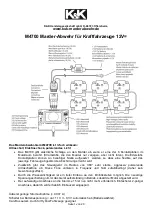
·
If there are any objects in the footwell,
remove them when the vehicle is
parked.
NOTICE
The pedals must be freely operable at all
times. For example, a larger brake pedal trav-
el will be necessary in order to stop the vehi-
cle if a brake circuit fails. The brake pedal will
have to be depressed further and harder than
normal.
Driving economically
Adopting the right driving style can re-
duce consumption, damage to the envi-
ronment, and wear and tear to the elec-
tric drive, brakes and tyres. The follow-
ing section lists a few tips for easing the
strain on the environment and your bank
account.
Think ahead when driving
The range will decrease if you do not adopt
a steady driving style. Keeping a close eye on
the traffic can help to avoid frequent acceler-
ation and braking. Keeping your vehicle at
a sufficient distance from the vehicle in front
can help you to think ahead when driving.
Use energy recovery (recuperation)
The vehicle will “coast” if the Eco assistance
function is deactivated and position D is se-
lected and the accelerator is not pressed.
The vehicle will perform brake energy recu-
peration automatically if the Eco assistance
function is activated and position D is selec-
ted and the accelerator is not pressed. It will
adapt itself to the driving situation and exter-
nal conditions such as vehicles in front and
speed limits. The energy of the rolling vehicle
is used to charge the high-voltage battery
→ page 135. The vehicle is braked as a result.
A high level of recuperation will take place if
the accelerator is not pressed in position B
→ page 140.
Recuperation is also increased if the brake
pedal is pressed.
Avoid full throttle
The rolling and air resistance increase at ex-
cessively high speeds. This in turn increases
the force needed to move the vehicle. This
will reduce the range of the vehicle. Never
drive the vehicle at top speed.
Have your vehicle serviced on a regular basis
Regular maintenance is an essential prerequi-
site for economical driving and increases the
service life of the vehicle.
Observe the correct tyre pressures
Low tyre pressures does not just mean great-
er wear, but also increases the rolling resist-
ance of the tyres and thus reduces the range
of the vehicle. Use tyres with optimised roll-
ing resistance.
Adjust the tyre pressure according to the ve-
hicle load:
— Observe the information on the tyre pres-
— Tyre Pressure Loss Indicator → page 325
Do not drive with unnecessary loads in the
vehicle
You can reduce energy consumption by clear-
ing out the luggage compartment before set-
ting off, for example by removing empty
drink crates or unused child seats.
In order to keep the drag coefficient of the
vehicle as low as possible, remove attach-
ments and add-on parts such as ski, bicycle
or roof carriers after use.
Save electrical energy
Convenience consumers such as the air con-
ditioning system or window heating require
energy from the high-voltage battery.
130
Driving
















































